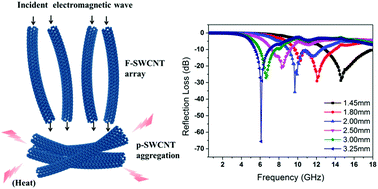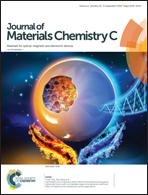Aligned fluorinated single-walled carbon nanotubes as a transmission channel towards attenuation of broadband electromagnetic waves†
Abstract
Ideal microwave absorbing materials need high impedance matching and high attenuation capacity. Towards this goal, in this paper, we present a novel lightweight and broadband electromagnetic wave absorber prepared through facile hybridization of fluorinated single-walled carbon nanotubes (SWCNTs) and pristine SWCNTs. Fluorinated SWCNTs are conveniently oriented under the action of stress due to the strong electrostatic interaction. Thus, the fluorinated SWCNT arrays with low permittivity and high impedance matching can function as a transmission channel to allow the directional propagation of electromagnetic waves. The pristine SWCNT network can guarantee high attenuation capacity for electromagnetic waves. Benefiting from the combination of high impedance matching and high attenuation ability, the hybrids exhibit enhanced microwave absorption performance with a minimal reflection loss of −65.6 dB with only 4.8 wt% loading. The hierarchical structures also endow the hybrid with multiple reflection loss peaks and thus a wide efficient absorption region (5.1 GHz, RL < −10 dB) at a thickness of only 1.45 mm. Besides, the hybrids display favorable low-frequency microwave absorption properties. We believe that the idea of constructing loss area and wave-transparent area can provide a guide to the design of other lightweight and broadband microwave absorbers.



 Please wait while we load your content...
Please wait while we load your content...